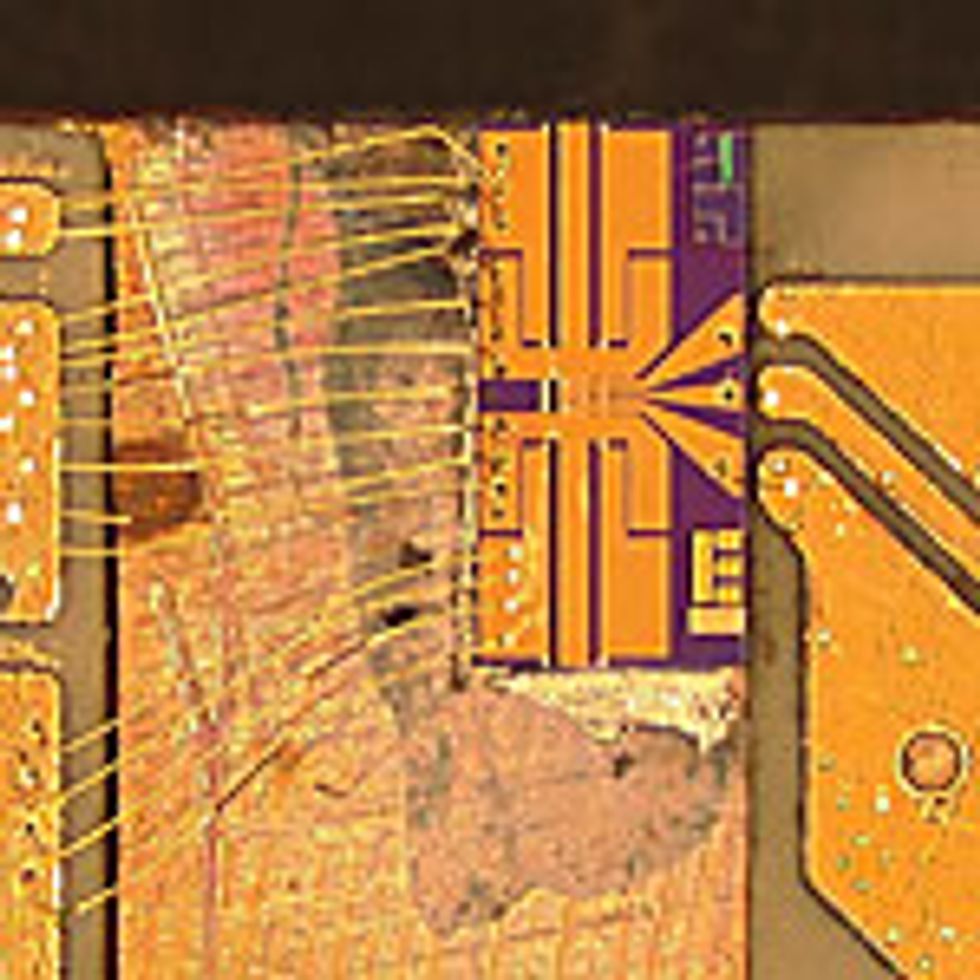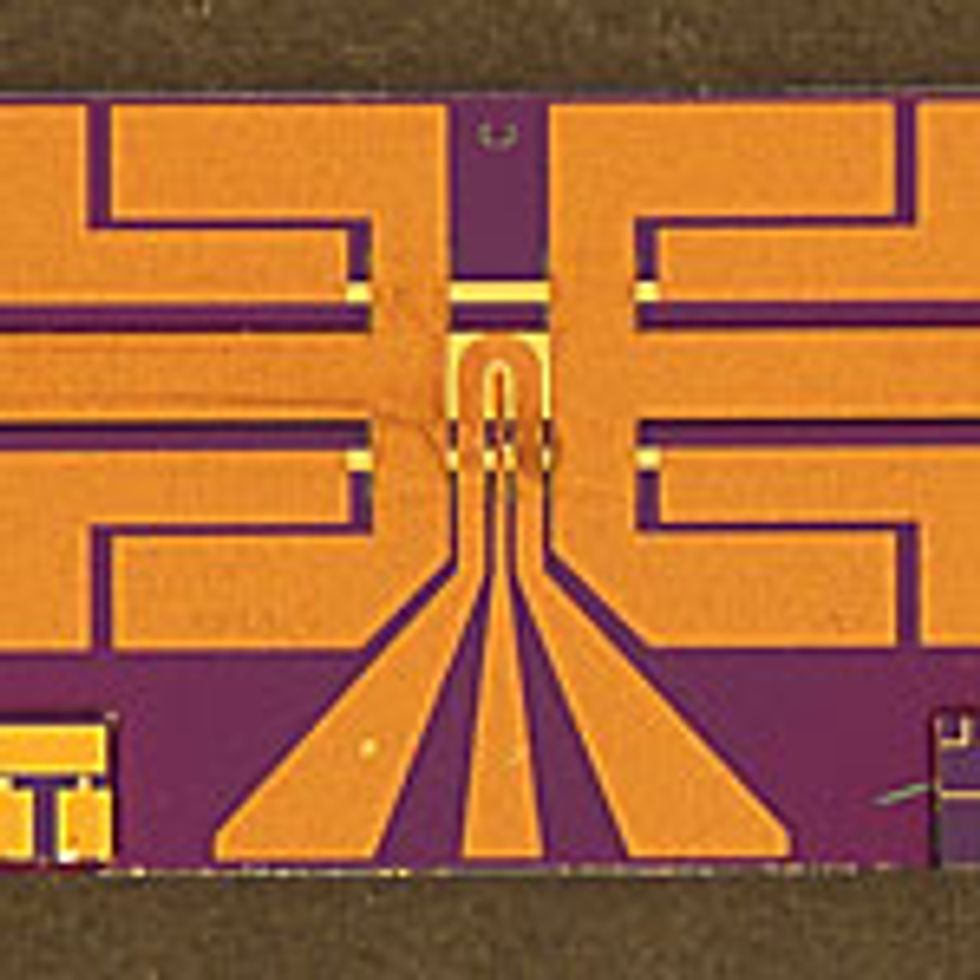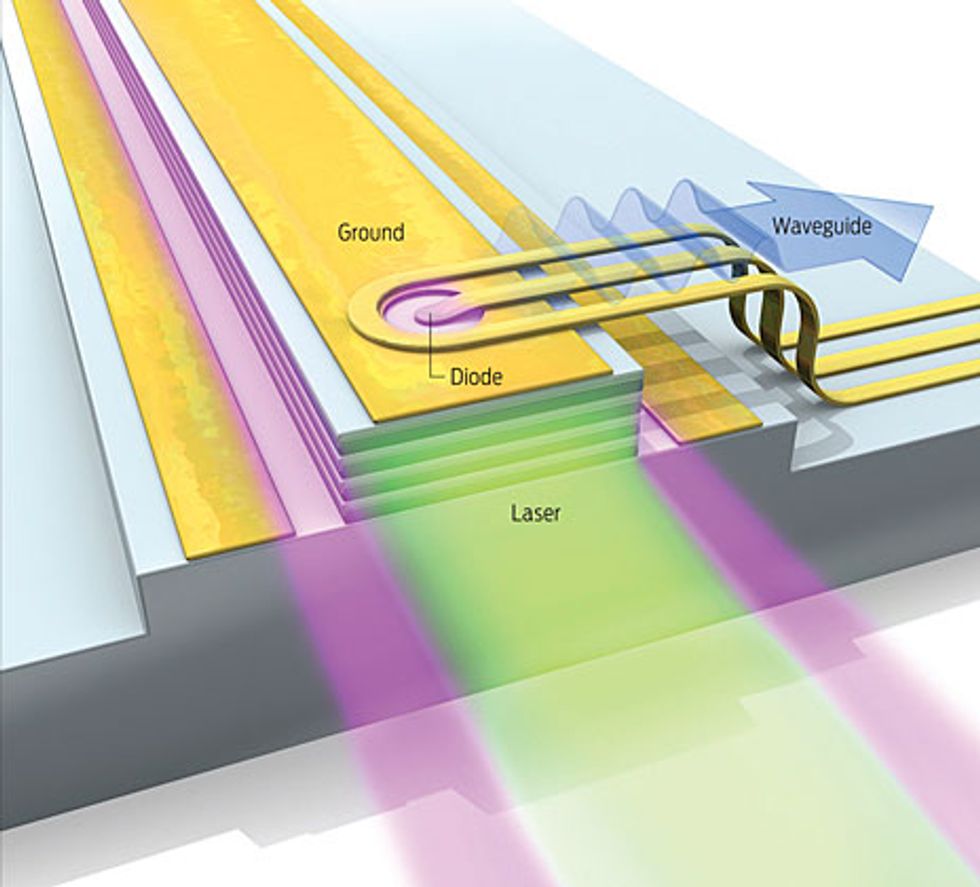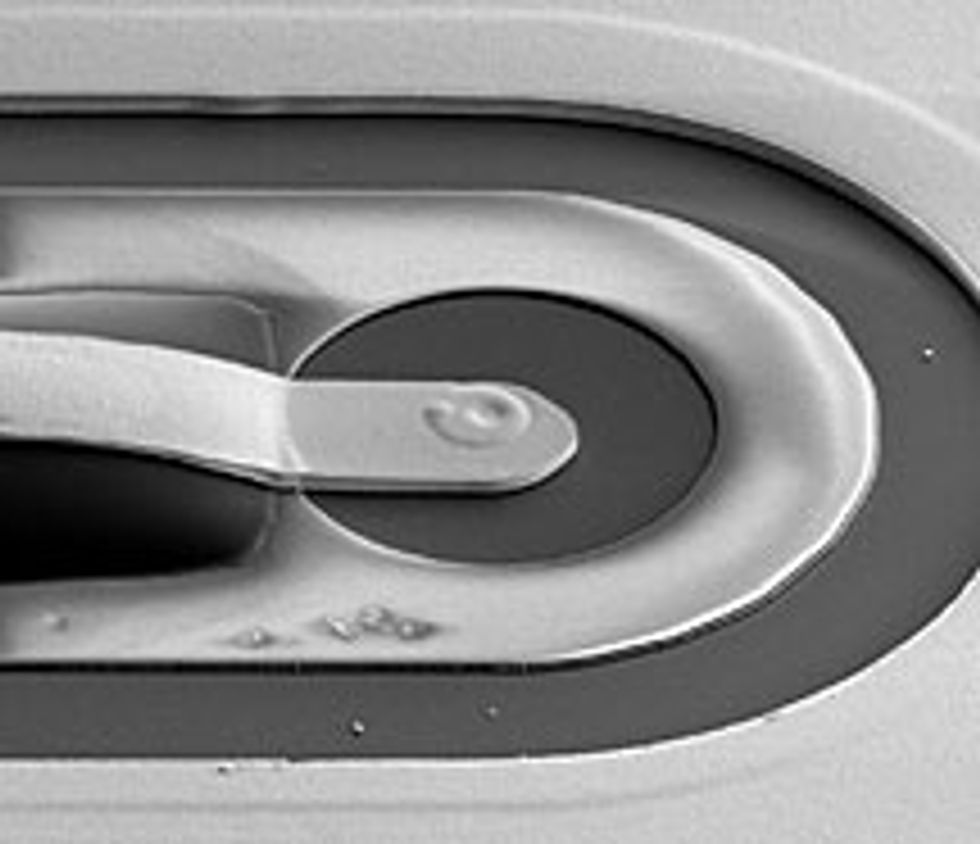Transceivers to Conquer the Terahertz Frontier
New ICs harness the untamed terahertz band

If we credit the integrated circuit with one thing, it should be the taming of the electromagnetic spectrum. If you want to create or capture visible photons, there are plenty of compact devices to choose from, incorporating everything from miniature photodiodes and lasers to LEDs and slim charge-coupled devices. And if you want to pick up or send a radio signal, there are a staggering number of receivers, transmitters, and antennas to suit your needs.
But the IC hasn't conquered every bit of the spectrum, and one region stands out: the terahertz frontier, a range that extends from the highest frequency radio waves to the lowest frequency infrared light. Over the decades, engineers have made many attempts to create compact, solid-state devices that can harness it, but terahertz radiation has proven particularly tricky to use.
Why does it matter? For one thing, terahertz radiation has a lot of promise for noninvasive imaging in industry, medicine, and security. Unlike X-rays, terahertz waves are too low in energy to knock electrons off atoms, which could damage living tissue. And because of their shorter wavelength, they can produce pictures that are far sharper than those made with microwaves, the current safe imaging alternative.
Terahertz waves also occupy a unique window of the electromagnetic spectrum where a large number of molecules emit and absorb radiation. The signals produced when a molecule jumps among rotational modes form a unique and highly distinctive chemical fingerprint. If we can devise compact, easy-to-manufacture terahertz spectrometers that can detect these fingerprints, we could, for example, use them to identify the constituents in a patient's breath or flag a potentially dangerous substance.
For a long time, these sorts of applications were out of reach. Until recently the only sources capable of creating significant power in the terahertz range have been custom-built, temperamental affairs that take up entire optical tables, are difficult to transport and calibrate, and can cost hundreds of thousands of dollars.
But recent research has shown that miniature sources can be just as powerful. And we've used these sources to make the first integrated devices that can simultaneously emit and detect terahertz radiation. These devices are proof that terahertz signals can be handled in a small, portable, mass-producible package. For the first time, we can begin to imagine a bright future for terahertz technology, one full of innovation.
The integrated circuit may be more than 50 years old, but constructing one that can operate at terahertz frequencies isn't trivial. It might not be immediately apparent why that's the case. After all, electromagnetic radiation, whether it's migrating through a transistor channel or emanating from a distant quasar, comes down to a single process: the propagation of electric and magnetic fields.
But materials aren't insensitive to frequency—even a factor-of-10 increase can have a big impact on device performance. As a result, over the years integrated circuit devices have essentially bifurcated. Low-frequency waves are the domain of solid-state electronics, where semiconductor transistors govern everything from wall currents oscillating at a lazy 60 hertz to radar and satellite communications that extend up to about a hundred gigahertz. Jumping up a factor of 1000 in frequency beyond the radio realm requires solid-state photonics, where semiconductor-based LEDs, lasers, and waveguides are used to create and manipulate near-infrared, visible, and ultraviolet light.
These two areas—the worlds of electronics and photonics—have given rise to a seemingly infinite array of products that have woven themselves into the fabric of modern life. But the terahertz realm, which spans the in-between range from a few hundred gigahertz to about 30 terahertz, hasn't proven so easy to exploit.
To make something as simple as a terahertz transceiver, a device that's capable of both emitting and detecting terahertz radiation, you might think that a few adjustments to a conventional electronic or photonic transceiver would do. But neither technology is really suitable for the task.
For example, if you try to adjust a radio transceiver so that it operates at terahertz frequencies, you'll quickly encounter fundamental physical limitations. The rapidly flipping voltage of a high-frequency alternating current can have strong electromagnetic effects on the transistors in a transceiver, giving rise to parasitic resistances and capacitances that take power away from the devices. More fundamentally, there is a speed limit on how fast electrons can move. Beyond a few tenths of a terahertz, the frequency of oscillations becomes so high that an electron can't cross a transistor channel from the source to the drain before the voltage flips its polarity, forcing the electron to reverse direction and causing transistor power to drop precipitously.
Approaching the terahertz frontier from the photonic end is no picnic either. To produce light from an LED or a semiconducting laser, you need a way to excite electrons so that they can then relax back to a particular lower energy state and emit photons. This mechanism is used to make visible and infrared light. Producing lower-frequency radiation in the terahertz range should be even easier. You need only supply electrons with a tiny energy kick, just 0.004 electron volt, less than 1 percent of what's needed to create visible light.
But it turns out there are a number of problems with this approach. For one, there's a dearth of practical materials with such a small bandgap. Another problem is that the small energy jump is, in fact, too small: The average room-temperature electron gets thermal kicks from its environment that are easily six times as big as the terahertz gap. These thermal kicks let electrons jump easily from one energy level to another, and they make it very difficult to corral enough electrons into the energy state needed to make usable light. The thermal energy problem lessens if you lower the temperature, but it doesn't go away. Even when an LED is cooled, you'll find that the device's power drops rapidly when the frequency is lowered beyond a few tens of terahertz.
The terahertz transceiver [bottom] uses a horizontal laser to pump the diode at its center. Waveguides [center] carry the transceiver's signals, which are at microwave frequencies, off the chip. The entire device [top] is mounted on a copper plate so it can be cooled. A coaxial connector carries signals off the chip.
Clearly, creating a transceiver that can operate at terahertz frequencies requires a different approach. And in 2005, at Sandia National Laboratories in Albuquerque, we set about figuring out what that approach might be. Our aim was to create the terahertz analog of an almost ubiquitous radio device: the heterodyne transceiver. The device needs two ingredients to operate: a local, stable source of electromagnetic waves with a well-defined frequency, and a mixing device that can combine incoming radiation with the light produced by this local source. The mixer in a heterodyne transceiver creates a new signal with a frequency equal to the difference in frequency between the two radiation sources. This property is ideal for terahertz detection: Heterodyne devices produce output signals with microwave frequencies, which, unlike terahertz radiation, can be handled easily by existing high-performance signal-processing electronics.
Convenient compact mixers that operate in the terahertz range have been around for many years in the form of Schottky diodes, simple devices made of metal and semiconducting material. These diodes have performed admirably as radio telescope detectors as well as in balloon-borne and satellite monitors of Earth's upper atmosphere.
But practical terahertz sources capable of powering these diode mixers have lagged behind. For decades, creating radiation above 1 THz involved zapping a tube of gas or vacuum with a laser or a beam of electrons. These sources have big footprints, and the light they produce must run a gantlet of carefully aligned mirrors and lenses. Portability is a difficult and expensive option.
Fortunately, an alternative terahertz source, one that can be mass-produced and requires just a few millimeters of real estate on a chip, is beginning to reach maturity. The technology got its start in the early 1990s, when two Bell Laboratories physicists, Federico Capasso and Jérôme Faist, found a way to circumvent the natural limitations of semiconductor materials. They discovered that they could create a powerful and tunable source of infrared radiation by alternating layers of semiconducting materials with large and small bandgap energies. Electrons are confined to the small bandgap layers, and when a voltage is applied, they can be encouraged to drop in energy and release a photon. As an electron tunnels through the many-layered device, it can make hundreds of identical energy-drop transitions, creating a cascade that generates additional light with each drop. The team called its device a quantum cascade laser (QCL).
The original QCLs were not true terahertz devices; they operated at midinfrared frequencies, from 30 to 80 THz. But in 2002, a team of researchers at the University of Pisa and the University of Cambridge unveiled a QCL that worked well down to 4.4 THz. This new device was capable of generating milliwatts of power, putting it close to the power output of the awkward tabletop sources.
The new QCL was a tour de force in precision engineering. The device boasted electron energy levels that were separated by one-tenth the energy of those in previous lasers. Constructing those levels required nearly atom-level control over semiconductor layer thicknesses—and the ability to maintain this control while growing many hundreds of layers in a process that could last more than 20 hours.
Part of the transceiver's diode, which acts as a terahertz detector, is built into a hole in the top layer of a quantum cascade laser. The terahertz radiation inside the laser is used to pump the diode directly, eliminating the need for mirrors and lenses.
With the advent of this compact terahertz source, we now had both of the ingredients we needed to construct miniature terahertz transceivers. But when we began working on such devices in 2005, we soon realized that the most obvious design—laying out a QCL and a Schottky diode mixer side by side on a chip—was not only inelegant but also fraught with problems.
A key issue was funneling the radiation from a QCL into the diode mixer. QCLs emit terahertz radiation over rather wide angles—30 degrees or more, depending on the type of waveguide that's used. Only a small fraction of this light can be beamed into a diode.
So instead of setting up the QCL and the Schottky diode in separate areas on the chip, we tried stacking them. Both the top electrical contact layer of a QCL and the cathode of a high-frequency Schottky diode are made of the same material: a heavily doped layer of the semiconductor gallium arsenide (GaAs). In principle, the two devices could share a common monolithic GaAs layer, sort of like conjoined twins.
Integrating the two devices let us deliver power from the local source to the mixer without any mirrors, lenses, or waveguides. The strategy—which effectively immersed the diode in the QCL's internal radiation—also allowed us to take advantage of a little-used property of lasers. Most of the light produced is reflected back into the interior, so the radiation inside a laser cavity is significantly stronger than what emerges. For QCLs, the interior power is up to 20 times as high as the output. Merging the diode with the QCL let us access this intense internal field. Then the entire output power of the QCL could be dedicated to transmitting terahertz radiation.
To combine the devices, we needed to create an opening in the top of the QCL for the diode's anode. Early on, we worried that the hole would disrupt the lasing process. Happily, by making the opening as small as possible, we were able to minimize any effects on the device.
But creating this monolithic design came with other hurdles. Although the QCL and the Schottky diode each use a layer of GaAs, the devices have quite different doping requirements. In the end, we devised a double layer containing two different doped regions, but some performance concessions were unavoidable.
Proving we had a working transceiver required three basic tests. The first was to show that the QCL coupled to the diode. For that, we designed our QCL to emit radiation at multiple, equally spaced frequencies centered around 2.8 THz and separated by 13 gigahertz. When we read off the output signal from the diode, we found a signal of 13 GHz, showing that the diode was directly coupling to the internal electromagnetic field in the QCL.
To prove the device could detect outside signals, we then shone 2.841143-THz light from a standard tabletop molecular gas laser onto the transceiver. Measuring the voltage changes on the diode's anode, we found several signals, all with frequencies that matched the difference between the frequency of this external light and the modes of the QCL.
Finally, to justify calling the device a true transceiver we needed to show that the device could simultaneously send out terahertz light and detect what came back. We did this by placing a mirror on the vibrating surface of a stereo speaker. When light from the QCL bounced off this moving mirror, its frequency shifted. We found that the frequency difference between the QCL's light and the reflected light immediately appeared in the output signal from the diode.
All told, our first working circuit—including the circuit board with the necessary electrical connectors but excluding the cryostat needed to cool the QCL—measured 2 square centimeters and weighed 14 grams. It's not the smallest integrated circuit, but it is a far cry from tube-based systems, which can easily occupy a square meter of space and weigh dozens of kilograms.
But there are still a few practical problems that will have to be overcome before these transceivers can be fabricated in bulk and placed in imagers and detectors. One key limitation is that terahertz QCLs need to be cooled to cryogenic temperatures to generate significant amounts of power. But the QCL community has greatly improved the cooling requirements. While the first devices needed to be chilled to within a few degrees of absolute zero, in the last few years basic terahertz QCLs developed at MIT and Sandia have run at 186 kelvins. That is still quite cold—almost 100 °C colder than the freezing point of water—but it is getting close to the point where thermoelectric coolers can be used to refrigerate the devices. And we expect operating temperatures to continue to improve.
Another hurdle is sensitivity. State-of-the-art tabletop detectors are a few thousand times as sensitive as these first integrated terahertz transceivers. But we haven't yet tried to optimize the performance of these proof-of-concept devices, and we expect there are ways to improve their sensitivity. Adding an antenna to a diode, for example, could help boost the strength of incoming signals. Embedding the diode more deeply in the top of the QCL could also improve sensitivity by delivering higher power to the device, which should make it easier to mix the QCL's light with external signals.
Of course, terahertz detectors will have their limits. The same property that makes terahertz radiation ideal for chemical identification also makes it difficult to detect, even across fairly short distances. Many molecules, including water vapor, readily absorb the light. Even the most sensitive terahertz detector likely won't be able to pick up low-altitude terahertz waves that originate more than a few hundred meters away.
So are integrated circuits based on QCLs the path toward filling in the terahertz technology gap? As with any field of active research, there is no general agreement on the best way forward.
QCLs have now been shown to emit light down to frequencies of 1.2 THz. And QCL output is now on a par with the power of traditional tube sources. The miniature lasers have even been shown to be effective sources for imaging devices, producing video-quality scans at rates of up to 30 frames per second.
Even so, researchers are aggressively pursuing other ways of producing and detecting terahertz radiation. Like QCLs, these alternative sources also employ techniques that go well beyond straightforward extrapolations of transistor or LED technologies. Some groups are using infrared lasers to trigger devices that can generate picosecond-long pulses that emit a broad range of terahertz radiation. Others are experimenting with more exotic technologies, including superconducting circuits and ways to convert the infrared light emitted by diode lasers down to terahertz frequencies.
In the future, these techniques could have advantages over the QCL-based approach. Because it emits light at a single well-defined frequency, a QCL-based heterodyne transceiver will work best when you know the specific frequency you're hoping to detect. It won't be well suited for broad-spectrum applications, such as identifying an unknown material, where the peaks and troughs in its spectrum will be at unknown frequencies. Other techniques offer very broad frequency coverage, although they do so at the expense of power and brightness. In the end, we may see multiple technologies settle the terahertz frontier.
This article originally appeared in print as "The Terahertz Frontier."
About the Authors
Michael C. Wanke is a principal member of technical staff at Sandia National Laboratories, in Albuquerque. Mark Lee, formerly of Sandia, is a physics professor at the University of Texas, Dallas. They met at Bell Laboratories more than 10 years ago, where Wanke worked on terahertz photonic devices and Lee focused on terahertz electronics. "It wasn't until we started working at Sandia that we realized we could blend the two approaches to make an integrated circuit," Wanke says.



